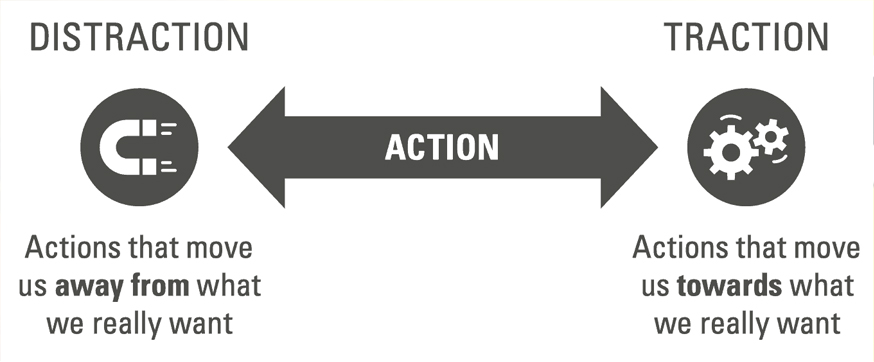Control the Day or the Day will control you
Being capable of achieving what you set out to do takes life control. People with effective life control are good at planning and time management and when required are comfortable when completing several things simultaneously.
They have the skills to realise that they may not have the time to do something right away and will plan to complete it later. A big part of managing the effectiveness of your time is avoiding derailing distractions.
Distraction, it turns out, isn’t about the distraction itself; rather, it’s about how we respond to it. Indistractable offers fantastic insights into the mechanisms of distraction and a systematic approach to creating behaviours that can help people avoid distractions and maintain traction.
Here we summarise the key aspects of Eyal & Li’s ‘Indistractable Model’.
Master Internal Triggers
What makes some user-friendly products and services engaging, easy to use, and simultaneously distracting? Have you found yourself being manipulated by time-wasting diversions? Have you experienced getting hooked by the tech-giants and their notification BINGS!!?
*The good news – if given a set of skills, as outlined in this series of articles, you can skilfully adapt to the threats of distraction by learning how to retain control over these assaults on your thinking.
Move away from distractions and towards what you really want…

What motivates us?
Jeremy Bentham identifies that nature has placed mankind under the governance of two sovereign masters, pain and pleasure. However, the drive to relieve discomfort is the greatest root cause of all our behaviour.
Therefore, to master distraction we must first learn to control discomfort. Without strategies to understand and skilfully tackle this process people often remain helpless victims in a tragedy of their own creation.
Eyal & Li identify that how we deal with uncomfortable internal triggers determines whether we pursue healthful acts of traction or self-defeating distractions. They attest:
- learn to understand the root cause of the internal distraction
- all motivation is a desire to escape discomfort
- anything that stops discomfort is potentially addictive
- if you can identify, and get to know, the drivers of your behaviour, you can manage them
According to Eyal & Li, if distraction costs us time, then skilful time management is pain management. They identify the importance of harnessing the power of dissatisfaction. This relies on quashing the misguided idea that if we are not happy we are not normal.
Deal with distraction from within – ACT
Eyal & Li highlight Bricker’s work, which shows how learning certain techniques as part of acceptance and commitment theory (ACT) can disarm the discomfort that so often leads to harmful distractions. ACT prescribes a method of giving ourselves time to observe uncomfortable feelings and their origins before responding to them.
But…Why not just say no to distractions (go cold turkey)? Eyal & Li effectively pose: ‘an endless cycle of resisting, ruminating, and finally giving in to desires perpetuates the cycle of distraction and quite possibly drives many of our unwanted behaviours’. They go on to suggest that without techniques for disarming temptation, mental abstinence can backfire.
Instead, manage the distractions, that originate from within, by changing how we mindfully think about them. Step back, noticing and observing distracting thoughts, and finally patiently letting the root desire disappear naturally (see the ‘ten- minute rule’).
Reimagine internal triggers
4 steps to help us handle intrusive (distracting) thoughts.
Step 1: Look for the discomfort that precedes distractions: mindfully focus on the internal trigger (feeling anxious, having a craving, feeling restless, or feeling you are incompetent).
Step 2: Write down the internal trigger: (time, what you were doing, how you felt). The better you are at noticing the behaviour, the better we will be at managing it over time.
Step 3: Explore your sensations (fingers twitching, butterflies in your stomach) when you are about to be distracted.
Bricker’s technique for skilfully responding and dealing with internal, distracting sensations: imagine you are seated beside a gentle flowing stream. Image leaves flowing slowly down the stream. Place each of your feelings/thoughts on the leaves. Just sit and watch the leaves swirl away down the stream. This will allow you to control these sensations (internal triggers).
Step 4: Beware of liminal moments (transitional moments in your day) These are the moments when you are venerable to distraction.
“The Ten-minute rule” – If you find yourself wanting to do something distracting (look at your phone, watch another episode of Netflix), tell yourself not to give in straight away. Give yourself 10 minutes before confirming your decision to follow through with the distracting behaviour, or not.
Reimagine the task
Eyal & Li investigate how to reframe tasks in order to avoid be derailed by more attractive, counter-productive distractions.
They suggest learning to reimagine difficult work as fun will prove incredibly empowering. By re-imaging otherwise dreary tasks they assure that we can master internal triggers, which lead to distraction. This supports that deliberateness and novelty can be added to any task to make it fun and the cure for boredom is curiosity.
‘Fun is the aftermath of deliberately manipulating a familiar situation in a new way’ (Bogost).
The Danger of Dwelling
Eyal & Li explore the idea of seeing the link between temperament and willpower (mindset). They explore imagining a task through a different lens and how this has profound implications for the way we focus our attention.
Denise Winterman suggests: if people could mitigate their tendency to self-blame and ruminate on a problem, they could almost completely mitigate the most common factors associated with depression and anxiety.
What we say to ourselves matters, so practice self compassion.
Ready to skilfully Gain traction
Whether working with individual clients, or teams of people, Get Mentally Fit aim to effectively support the embedding of sustainable, positive behaviour. Our programs and services are customised to achieve the identified outcomes for all clients. This could include learning skills to minimise the disruptive effects of distraction. Contact us to inquire into how we can support you through this process.
Additional resources
Zoe Chance, ‘How to Make a Behaviour Addictive’, TEDx talk at TEDxMillRiver (2010) http://www.youtube.com/watch?v=AHfiKav9fcQ
Timothy D. Wilson et al., ‘Just Think: The Challenges of the Disengaged Mind’, Science 345, no. 6192 (2014), 75-77. http://doi.org/10.1126/science.1250830


